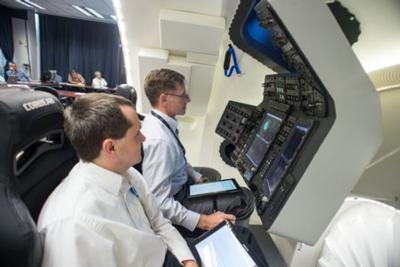Sat, Mar 01, 2014
Simulated Mission Satisfies A NASA Testing Requirement
Chris Ferguson, Boeing's director of Crew and Mission Operations and commander of the final Space Shuttle flight, virtually returned to space recently in the Boeing Crew Space Transportation (CST)-100 simulator to satisfy a NASA testing requirement for the spacecraft.

Ferguson performed manual piloting activities including on-orbit attitude and translation maneuvers, docking and backing away from a virtual International Space Station and a manual re-entry to Earth in the simulator. "It was great to be back in the pilot’s seat, even if I didn't leave the ground," Ferguson said. "It's important for the spacecraft to have manual controls because although it's designed to be largely autonomous, the pilot should always be able to back up that autonomy. Manual flight controls provide a sort of a belt-and-suspenders capability for piloting the spacecraft."
The testing for NASA officials satisfied a CST-100 development milestone known as "Pilot in the Loop." It is the final milestone before the spacecraft's critical design review.
Ferguson, a veteran of three shuttle missions and commander of STS-135, the final shuttle flight, has logged more than 40 days in space and 5,700 hours in high-performance aircraft. He now oversees the crew interface of the Boeing CST-100 spacecraft and plays a key role in development and testing of system concepts and technologies for the vehicle and integrated launch and ground systems.
"This was the one opportunity to really show off, from a user's perspective, just how real our vehicle is becoming," said Ferguson. "We demonstrated that the CST-100 is on track to return Americans to space in an American spacecraft."
The simulator will be used for preliminary astronaut training while Boeing builds additional units dedicated exclusively to training astronauts and mission controllers.
(Image provided by Boeing. Pictured: Ferguson (center) and Boeing Commercial Crew Design Team lead Steve Everett)
More News
Airport Marking Aids Markings used on runway and taxiway surfaces to identify a specific runway, a runway threshold, a centerline, a hold line, etc. A runway should be marked in ac>[...]
"It is extremely difficult, if not impossible, for manned aircraft to see a drone while conducting crop-enhancing and other aerial applications at low altitudes and high speeds. We>[...]
Aero Linx: The Skyhawk Association The Skyhawk Association is a non-profit organization founded by former Skyhawk Pilots which is open to anyone with an affinity for the A-4 Skyhaw>[...]
“The T-54A benefits from an active Beechcraft King Air assembly line in Wichita, Kansas, where all required METS avionics and interior modifications are installed on the line>[...]
Aero Linx: Aerostar Owners Association The Association offers the Aerostar Owner a unique opportunity to tap an invaluable source of information concerning the care and feeding of >[...]
 ANN's Daily Aero-Term (04.28.24): Airport Marking Aids
ANN's Daily Aero-Term (04.28.24): Airport Marking Aids Aero-News: Quote of the Day (04.28.24)
Aero-News: Quote of the Day (04.28.24) ANN's Daily Aero-Linx (04.28.24)
ANN's Daily Aero-Linx (04.28.24) Aero-News: Quote of the Day (04.29.24)
Aero-News: Quote of the Day (04.29.24) ANN's Daily Aero-Linx (04.29.24)
ANN's Daily Aero-Linx (04.29.24)



